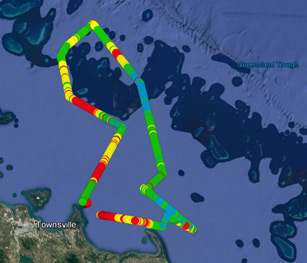Organization
Australian Institute of Marine Science (AIMS)
Mission Location
The Great Barrier Reef and waters of northwest Australia
Highlights
- Collected environmental data on the Great Barrier Reef, including wave height, currents, and chlorophyll
- Transmitted data in real-time while staying on course in the dense reef matrix
- Navigated in strong currents and tides in North West Australia
“We are impressed with the number of different measurements it could conduct at the same time and its ability to transmit the data back to our base immediately and reliably while navigating and performing its mission.”
The Challenge
With 85% of the population living in coastal areas, and a marine economy contributing $73B annually, Australia’s well-being is inextricably tied to the ocean. Since 1972, the Australian Institute of Marine Science (AIMS), Australia’s tropical marine science agency, has been committed to the protection and sustainable use of Australia’s marine resources.
AIMS conducts scientific research that helps government, industry and the wider community make informed decisions about the health, use, and protection of Australia’s waters. Their work focuses on three key areas:
- A healthy and resilient Great Barrier Reef
- Sustainable coastal ecosystems and industries across northern Australia
- Environmentally sustainable offshore oil and gas development
As AIMS conducts their research, a central challenge is one of efficiency and scale: how to reduce costs, monitor larger areas, and get the data back to shore quickly. To be most effective, they need to speed up the process of converting observations into actionable insights.
Over the course of two missions, Liquid Robotics worked with AIMS to demonstrate how a long-duration autonomous ocean vehicle can improve monitoring of the Great Barrier Reef and support monitoring operations such as in the waters of northwest Australia.
Monitoring the Great Barrier Reef
As part of a five-year joint research agreement between AIMS and Boeing (Liquid Robotics’ parent company), the first major milestone was a seven-day, 200 nautical mile trial mission on the Great Barrier Reef off the north-eastern coast of Australia. The Wave Glider was deployed in the central section of the reef and provided continuous, real-time environmental ocean data including currents, wave height, salinity, temperature, chlorophyll, turbidity and dissolved oxygen.
AIMS initially had some concerns as to whether the wave and solar powered Wave Glider would be able to stay on course, particularly in the dense reef matrix of the central reef. What if they lost control of the vehicle and hit a reef? Those fears were quickly put to rest. “It was quite extraordinary how the Wave Glider remained on its planned mission,” Dr. Llewellyn said. “It went where it was told to and it stayed the course like an orienteering champion.” This performance increased the researchers’ confidence about how close they might be able to go into the reef on future missions, providing the opportunity to access places that a ship cannot go.

The Wave Glider gathered data on changes in Chlorophyll-a along the mission path in the Great Barrier Reef.
Offshore Monitoring in North West Australia
The second mission demonstrated how the Wave Glider could collect meteorological and oceanographic data in North West Australia, a region with notoriously strong currents and tides and home to one of the largest underwater oil and gas provinces in the world as well as new and remote marine protected areas.
A key objective of this trial was to demonstrate the reliability of the Wave Glider in strong currents and tides to determine how intensively the vehicle would need to be managed during a long surveillance assignment. Over the course of the mission, the Wave Glider proved capable of a range of monitoring operations such as holding station over a 5m tidal cycle, with only limited cases where a shore-side pilot needed to more closely manage power consumption and navigation to stay on course.
In addition to demonstrating the ease-of-use and operational capabilities of the vehicle, this mission also showcased the Wave Glider’s ability to transmit data in real time, enabling faster decision-making.
Photos by Marie Roman